LG LGD722K.AAUSKG User Manual

ENGLISH
User Guide
LG-D722k
MFL68581429 (1.0) |
www.lg.com |

ENGLISH
User Guide
•Screen displays and illustrations may differ from those you see on actual phone.
•Some of the contents of this guide may not apply to your phone, depending on the software and your service provider. All information in this document is subject to change without notice.
•This handset is not suitable for people who have a visual impairment due to the tap screen keyboard.
•Copyright ©2014 LG Electronics, Inc. All rights reserved. LG and the LG logo are registered trademarks of LG Group and its related entities. All other trademarks are the property of their respective
owners.
• Google™, Google Maps™, Gmail™, YouTube™, Hangouts™ and Play Store™ are trademarks of Google, Inc.

Table of contents |
|
Guidelines for safe and efficient use................. |
5 |
Important notice ............................................... |
13 |
Getting to know your phone............................. |
17 |
Phone overview............................................... |
17 |
Installing the SIM card and battery .................. |
19 |
Charging your phone....................................... |
21 |
Using the memory card ................................... |
22 |
Locking and unlocking the screen ................... |
23 |
Your Home screen............................................. |
24 |
Touch screen tips............................................ |
24 |
Home screen................................................... |
24 |
Extended home screen.................................. |
25 |
Customising the Home screen ....................... |
26 |
Returning to recently-used applications........... |
27 |
Notifi cations panel........................................... |
27 |
Opening the notifi cations panel...................... |
28 |
Indicator icons on the Status Bar.................... |
28 |
On-screen keyboard........................................ |
30 |
Entering accented letters............................... |
30 |
Google account setup....................................... |
31 |
Connecting to Networks and Devices.............. |
32 |
Wi-Fi ............................................................... |
32 |
Connecting to Wi-Fi networks ........................ |
32 |
Turning Wi-Fi on and connecting to a Wi-Fi |
|
network........................................................ |
32 |
Bluetooth ........................................................ |
33 |
Sharing your phone's data connection............. |
34 |
Wi-Fi Direct..................................................... |
35 |
SmartShare..................................................... |
35 |
Enjoying the content from Nearby devices....... |
36 |
PC connections with a USB cable .................... |
36 |
Calls .................................................................. |
38 |
Making a call .................................................. |
38 |
Calling your contacts....................................... |
38 |
Answering and rejecting a call......................... |
38 |
Adjusting the in-call volume ............................ |
38 |
Making a second call ...................................... |
39 |
Viewing your call logs...................................... |
39 |
Call settings .................................................... |
39 |
Contacts............................................................ |
40 |
Searching for a contact ................................... |
40 |
Adding a new contact...................................... |
40 |
Favourites contacts ......................................... |
40 |
Creating a group ............................................. |
41 |
Messaging......................................................... |
42 |
Sending a message......................................... |
42 |
Threaded box ................................................. |
42 |
Changing your message settings..................... |
43 |
E-mail................................................................ |
44 |
Managing an email account ............................ |
44 |
Working with account folders .......................... |
44 |
Composing and sending email......................... |
44 |
Camera and Video............................................. |
45 |
Getting to know the viewfi nder........................ |
45 |
Using the advanced settings............................ |
46 |
Taking a quick photo ...................................... |
46 |
Once you've taken a photo .............................. |
47 |
Gesture shot.................................................... |
48 |
2

Using Panorama mode ................................... |
48 |
Recording a quick video .................................. |
49 |
After recording a video .................................... |
49 |
From your Gallery............................................ |
50 |
Function ............................................................ |
51 |
Guest Mode ................................................... |
51 |
Knock Code..................................................... |
51 |
KnockON......................................................... |
51 |
QuickMemo+ .................................................. |
52 |
Using the QuickMemo+ options..................... |
53 |
Viewing the saved QuickMemo+ ................... |
53 |
QSlide ............................................................. |
54 |
QuickRemote .................................................. |
55 |
Smart Keyboard .............................................. |
56 |
Live Zooming .................................................. |
57 |
Multimedia........................................................ |
58 |
Gallery ............................................................ |
58 |
Viewing pictures ........................................... |
58 |
Playing videos............................................... |
58 |
Editing photos............................................... |
59 |
Deleting photos/videos .................................. |
60 |
Setting as wallpaper...................................... |
60 |
Music.............................................................. |
60 |
Playing a song.............................................. |
60 |
Add music fi les to your phone........................ |
62 |
Transfer music using Media device (MTP)....... |
62 |
FM radio ......................................................... |
63 |
Utilities .............................................................. |
64 |
Setting your alarm........................................... |
64 |
Using your calculator....................................... |
64 |
Adding an event to your calendar .................... |
64 |
Voice Recorder................................................ |
65 |
Recording a sound or voice ........................... |
65 |
Tasks .............................................................. |
65 |
ThinkFree Viewer............................................. |
65 |
Google+.......................................................... |
66 |
Voice Search ................................................... |
66 |
Downloads...................................................... |
66 |
LG SmartWorld................................................ |
67 |
How to Get to LG SmartWorld from Your |
|
Phone .......................................................... |
67 |
The Web ............................................................ |
68 |
Internet ........................................................... |
68 |
Using the Web toolbar ................................... |
68 |
Viewing webpages ........................................ |
68 |
Opening a page ............................................ |
68 |
Bookmarks................................................... |
69 |
History ......................................................... |
69 |
Chrome........................................................... |
69 |
Viewing webpages ........................................ |
69 |
Opening a page ............................................ |
69 |
Syncing with other devices ............................ |
69 |
Settings............................................................. |
70 |
Networks ........................................................ |
70 |
Sound ............................................................. |
72 |
Display............................................................ |
73 |
General ........................................................... |
74 |
PC software (LG PC Suite) ................................ |
78 |
Phone software update .................................... |
80 |
Phone software update.................................... |
80 |
About this user guide ....................................... |
81 |
About this user guide ...................................... |
81 |
Trademarks..................................................... |
81 |
3

Table of contents |
|
Accessories....................................................... |
82 |
Troubleshooting ................................................ |
83 |
FAQ .................................................................... |
86 |
4

Guidelines for safe and efficient use
Please read these simple guidelines. Not following these guidelines may be dangerous or illegal. Should a fault occur, a software tool is built into your device that will gather a fault log.
This tool gathers only data specific to the fault, such as signal strength, cell ID position in sudden call drop and applications loaded. The log is used only to help determine the cause of the fault. These logs are encrypted and can only be accessed by an authorised LG Repair centre should you need to return your device for repair.
Exposure to radio frequency energy
Radio wave exposure and Specific Absorption Rate (SAR) information.
This mobile phone model LG-D722k has been designed to comply with applicable safety requirements for exposure to radio waves. These requirements are based on scientific guidelines that include safety margins designed to assure the safety of all persons, regardless of age and health.
•The radio wave exposure guidelines employ a unit of measurement known as the Specific Absorption Rate (SAR). Tests for SAR are conducted using standardised methods with the phone transmitting at its highest certified power level in all used frequency bands.
•While there may be differences between the SAR levels of various LG phone models, they are all designed to meet the relevant guidelines for exposure to radio waves.
•The SAR limit recommended by the International Commission on Non-Ionizing Radiation Protection (ICNIRP) is 2 W/kg averaged over 10g of tissue.
•The highest SAR value for this model phone tested for use at the ear is 0.851 W/kg (10g) and when worn on the body is 0.588 W/Kg (10g).
•This device meets RF exposure guidelines when used either in the normal use position against the ear or when positioned at least 1.5 cm away from the body. When a carry case, belt clip or holder is used for bodyworn operation, it should not contain metal and should position the product at least 1.5 cm away from your body. In order to transmit data files or messages, this device requires a quality connection to the network.
In some cases, transmission of data files or messages may be delayed until such a connection is available. Ensure the above separation distance instructions are followed until the transmission is completed.
5

Guidelines for safe and efficient use
Product care and maintenance
 WARNING
WARNING
Only use batteries, chargers and accessories approved for use with this particular phone model. The use of any other types may invalidate any approval or warranty applying to the phone and may be dangerous.
• Do not disassemble this unit. Take it to a qualified service technician when repair work is required.
•Repairs under warranty, at LG's discretion, may include replacement parts or boards that are either new or reconditioned, provided that they have functionality equal to that of the parts being replaced.
•Keep away from electrical appliances such as TVs, radios and personal computers.
•The unit should be kept away from heat sources such as radiators or cookers.
•Do not drop.
•Do not subject this unit to mechanical vibration or shock.
•Switch off the phone in any area where you are required to by special regulations. For example, do not use your phone in hospitals as it may affect sensitive medical equipment.
•Do not handle the phone with wet hands while it is being charged. It may cause an electric shock and can seriously damage your phone.
•Do not charge a handset near flammable material as the handset can become hot and create a fire hazard.
•Use a dry cloth to clean the exterior of the unit (do not use solvents such as benzene, thinner or alcohol).
•Do not charge the phone when it is on soft furnishings.
•The phone should be charged in a well ventilated area.
•Do not subject this unit to excessive smoke or dust.
•Do not keep the phone next to credit cards or transport tickets; it can affect the information on the magnetic strips.
•Do not tap the screen with a sharp object as it may damage the phone.
•Do not expose the phone to liquid or moisture.
•Use accessories like earphones cautiously. Do not touch the antenna unnecessarily.
•Do not use, touch or attempt to remove or fix broken, chipped or cracked glass. Damage to the glass display due to abuse or misuse is not covered under the warranty.
•Your phone is an electronic device that generates heat during normal operation. Extremely prolonged, direct skin contact in the absence of adequate ventilation may result in discomfort or minor burns. Therefore, use care when handling your phone during or immediately after operation.
6

•If your phone gets wet, immediately unplug it to dry off completely. Do not attempt to accelerate the drying process with an external heating source, such as an oven, microwave or hair dryer.
•The liquid in your wet phone, changes the color of the product label inside your phone. Damage to your device as a result of exposure to liquid is not covered under your warranty.
Efficient phone operation
Electronics devices
All mobile phones may receive interference, which could affect performance.
•Do not use your mobile phone near medical equipment without requesting permission. Avoid placing the phone over pacemakers, for example, in your breast pocket.
•Some hearing aids might be disturbed by mobile phones.
•Minor interference may affect TVs, radios, PCs etc.
•Use your phone in temperatures between 0ºC and 40ºC, if possible. Exposing your phone to extremely low or high temperatures may result in damage, malfunction, or even explosion.
Road safety
Check the laws and regulations on the use of mobile phones in the area when you drive.
•Do not use a hand-held phone while driving.
•Give full attention to driving.
•Pull off the road and park before making or answering a call if driving conditions so require.
•RF energy may affect some electronic systems in your vehicle such as car stereos and safety equipment.
•When your vehicle is equipped with an air bag, do not obstruct with installed or portable wireless equipment. It can cause the air bag to fail or cause serious injury due to improper performance.
•If you are listening to music whilst out and about, please ensure that the volume is at a reasonable level so that you are aware of your surroundings. This is of particular importance when near roads.
7

Guidelines for safe and efficient use
Avoid damage to your hearing
To prevent possible hearing damage, do not listen at high volume levels for long periods.
Damage to your hearing can occur if you are exposed to loud sound for long periods of time. We therefore recommend that you do not turn on or off the handset close to your ear. We also recommend that music and call volumes are set to a reasonable level.
•When using headphones, turn the volume down if you cannot hear the people speaking near you, or if the person sitting next to you can hear what you are listening to.
NOTE: Excessive sound pressure from earphones and headphones can cause hearing loss
Glass Parts
Some parts of your mobile device are made of glass. This glass could break if your mobile device is dropped on a hard surface or receives a substantial impact. If the glass breaks, do not touch or attempt to remove it. Stop using your mobile device until the glass is replaced by an authorised service provider.
Blasting area
Do not use the phone where blasting is in progress. Observe restrictions and follow any regulations or rules.
Potentially explosive atmospheres
•Do not use your phone at a refueling point.
•Do not use near fuel or chemicals.
•Do not transport or store flammable gas, liquid or explosives in the same compartment of your vehicle as your mobile phone or accessories.
8

In aircraft
Wireless devices can cause interference in aircraft.
•Turn your mobile phone off before boarding any aircraft.
•Do not use it on the ground without permission from the crew.
Children
Keep the phone in a safe place out of the reach of small children. It includes small parts which may cause a choking hazard if detached.
Emergency calls
Emergency calls may not be available on all mobile networks. Therefore you should never depend solely on your phone for emergency calls. Check with your local service provider.
•Use your mobile phone to call emergency services for yourself or others in the case of fire, traffic accident or medical emergencies;
-Australia Dial (0-0-0)
-New Zealand Dial (1-1-1)
-International Dial (1-1-2)
-other local emergency number.
Remember, it is a free call when dialling emergency services from your mobile phone in Australia.
Battery information and care
•You do not need to completely discharge the battery before recharging. Unlike other battery systems, there is no memory effect that could compromise the battery's performance.
•Use only LG batteries and chargers. LG chargers are designed to maximise the battery life.
•Do not disassemble or short-circuit the battery.
•Replace the battery when it no longer provides acceptable performance. The battery pack may be recharged hundreds of times before it needs replacing.
•Recharge the battery if it has not been used for a long time to maximise usability.
9

Guidelines for safe and efficient use
•Do not expose the battery charger to direct sunlight or use it in high humidity, such as in the bathroom.
•Do not leave the battery in hot or cold places, as this may deteriorate battery performance.
•There is risk of explosion if the battery is replaced with an incorrect type.
•Dispose of used batteries according to the manufacturer's instructions. Please recycle when possible. Do not dispose as household waste.
•If you need to replace the battery, take it to the nearest authorised LG Electronics service point or dealer for assistance.
•Always unplug the charger from the wall socket after the phone is fully charged to save unnecessary power consumption of the charger.
•Actual battery life will depend on network configuration, product settings, usage patterns, battery and environmental conditions.
•Make sure that no sharp-edged items such as animal’s teeth or nails, come into contact with the battery. This could cause a fire.
Driver Safety Tips
Your mobile telephone gives you the powerful ability to communicate almost anywhere, anytime, but an important responsibility accompanies the benefits of mobile phones, one that every user must uphold. When driving a
car, driving is your first responsibility. When using your mobile phone behind the wheel of a car, practice good common sense and remember the following tips:
•Use a hands free device to add an additional layer of convenience and safety to your wireless phone with one of the many hands free accessories available today.
•Let the person you are speaking with know you are driving; if necessary, suspend the call in heavy traffic or hazardous weather conditions. Rain, sleet, snow, ice and even heavy traffic can be hazardous.
•Do not take notes or look up phone numbers while driving. Typing up a “to do” list or flipping through your address book takes attention away from your primary responsibility of driving safely.
• Place calls when you are not moving or before pulling into traffic. Try to plan calls when you will not be driving.
•Do not engage in stressful or emotional conversations that may be distracting. Make people you are talking with aware you are driving and suspend conversations that have the potential to divert your attention from the road.
•Use your mobile phone to help others in emergencies. If you see an auto accident, crime in progress or other serious emergency where lives are in danger, call the emergency number, as you would want others to do for you.
10
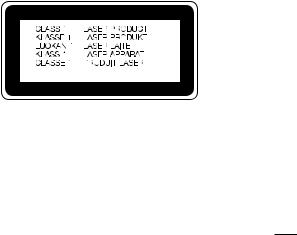
•If you see a broken down vehicle posing no serious hazard, a broken traffic signal, a minor traffic accident where no one appears injured, or a vehicle you know to be stolen, call roadside assistance, local traffic authority or police station.
Laser safety statement
Caution!
This product employs a Laser system. To ensure proper use of this product, please read this owner's manual carefully and retain for future reference. Should the unit require maintenance, contact an authorised service center.
Use of controls, adjustments, or the performance of procedures other than those specified herein may result in hazardous radiation exposure.
To prevent direct exposure to laser beam, do not try to open the enclosure or make direct contact with the laser.
11

Guidelines for safe and efficient use
DECLARATION OF CONFORMITY
Hereby, LG Electronics declares that this LG-D722k product is in compliance with the essential requirements and other relevant provisions of Directive 1999/5/EC. A copy of the Declaration of Conformity can be found at http://www.lg.com/global/declaration
Contact office for compliance of this product :
LG Electronics Inc.
EU Representative, Krijgsman 1,
1186 DM Amstelveen, The Netherlands
12

Important notice
Please read this before you start using your phone!
Please check to see whether any problems you encountered with your phone are described in this section before taking the phone in for service or calling a service representative.
1. Phone memory
When there is less than 10% of space available in your phone memory, your phone cannot receive new messages. You need to check your phone memory and delete some data, such as applications or messages, to make more memory available.
To uninstall applications:
1 Tap  >
>  > Apps tab > Settings > General tab > Apps.
> Apps tab > Settings > General tab > Apps.
2 Once all applications appear, scroll to and select the application you want to uninstall.
3 Tap Uninstall.
2. Optimizing battery life
Extend your battery's power by turning off features that you don't have to run constantly in the background. You can monitor how applications and system resources consume battery power.
Extending your phone's battery life:
•Turn off radio communications when you are not using. If you are not using Wi-Fi, Bluetooth or GPS, turn them off.
•Reduce screen brightness and set a shorter screen timeout.
•Turn off automatic syncing for Gmail, Calendar, Contacts and other applications.
•Some applications you have downloaded may reduce battery power.
•While using downloaded applications, check the battery charge level.
To check the battery power level:
• Tap 

 >
>  > Apps tab > Settings > General tab > About phone > Battery.
> Apps tab > Settings > General tab > About phone > Battery.
The battery status (charging or discharging) and battery level (percentage charged) is displayed at the top of the screen.
13

Important notice
To monitor and control how battery power is being used:
• Tap 

 >
>  > Apps tab > Settings > General tab > About phone > Battery > Battery use. Battery usage time is displayed on the screen. It tells you how long it has been since you last connected your phone to a power source or, if currently connected, how long the phone was last running on battery power. The screen shows the applications or services using battery power, listed in order from the greatest to smallest amount used.
> Apps tab > Settings > General tab > About phone > Battery > Battery use. Battery usage time is displayed on the screen. It tells you how long it has been since you last connected your phone to a power source or, if currently connected, how long the phone was last running on battery power. The screen shows the applications or services using battery power, listed in order from the greatest to smallest amount used.
3. Before installing an open source application and OS
 WARNING
WARNING
If you install and use an OS other than the one provided by the manufacturer it may cause your phone to malfunction. In addition, your phone will no longer be covered by the warranty.
 WARNING
WARNING
To protect your phone and personal data, only download applications from trusted sources, such as Play Store™. If there are improperly installed applications on your phone, the phone may not work normally or a serious error may occur. You must uninstall those applications and all associated data and settings from the phone.
4. Using an unlock pattern
Set an unlock pattern to secure your phone. Tap 

 >
>  > Apps tab > Settings > Display tab > Lock screen > Select screen lock > Pattern. This opens a screen that will guide you through how to draw a screen unlock pattern. You have to create a Backup PIN as a safety measure in case you forget your unlock pattern.
> Apps tab > Settings > Display tab > Lock screen > Select screen lock > Pattern. This opens a screen that will guide you through how to draw a screen unlock pattern. You have to create a Backup PIN as a safety measure in case you forget your unlock pattern.
Caution: Create a Google account before setting an unlock pattern and remember the Backup PIN you created when creating your pattern lock.
14

 WARNING
WARNING
Precautions to take when using pattern lock.
It is very important to remember the unlock pattern you set. You will not be able to access your phone if you use an incorrect pattern 5 times. You have 5 opportunities to enter your unlock pattern, PIN or password. If you have used all 5 opportunities, you can try again after 30 seconds.
When you can’t recall your unlock Pattern, PIN or Password: < If you have forgotten your pattern >
If you logged in to your Google account on the phone but failed to enter the correct pattern 5 times, tap the Forgot pattern? button at the bottom of the screen. You are then required to log in with your Google Account or you have to enter the Backup PIN which you entered when creating your Pattern Lock.
If you have not created a Google account on the phone or you forgot Backup PIN, you have to perform a hard reset.
< If you have forgotten your PIN or Password >
If you forget your PIN or Password, you will need to perform a hard reset.
Caution: If you perform a hard reset, all user applications and user data will be deleted.
NOTE: If you have not logged into your Google Account and have forgotten your Unlock Pattern, you will need to enter your Backup PIN.
5. Using the Hard Reset (Factory Reset)
If your phone does not restore to its original condition, use a Hard Reset (Factory Reset) to initialise it. 1 Turn the power off.
2 Press and hold the Power/Lock Key + Volume Down Key on the phone.
3Release the Power/Lock Key only when the LG logo is displayed, then immediately press and hold the
Power/Lock Key again.
4 Release all keys when the Factory data reset screen is displayed.
5 Press the Volume Key to scroll to the desired option, then press the Power/Lock Key to confi rm.
6Press the Volume Key to scroll to the desired option, then press the Power/Lock Key to confi rm one more time.
15

Important notice
 WARNING
WARNING
If you perform a Hard Reset, all user applications, user data and DRM licenses will be deleted. Please remember to backup any important data before performing a Hard Reset.
6. Opening and switching applications
Multi-tasking is easy with Android, you can keep more than one application running at the same time. There is no need to quit an application before opening another one. Use and switch between several open applications. Android manages each application, stopping and starting them as needed to ensure that idle applications don't consume resources unnecessarily.
1 Touch Recent Key  . A list of recently used applications will be displayed.
. A list of recently used applications will be displayed.
2Tap the application you want to access. This does not stop the previous app running in the background on the phone. Make sure to tap Back Key 

 to exit an app after using it.
to exit an app after using it.
•To remove an app from the recent apps list, swipe the app preview to the left or right. To clear all apps, tap
Clear all.
7. Transferring music, photos and videos using Media sync (MTP)
1 Tap 

 >
>  > Apps tab > Settings > General tab > Storage to check out the storage media. 2 Connect the phone to your PC using the USB cable.
> Apps tab > Settings > General tab > Storage to check out the storage media. 2 Connect the phone to your PC using the USB cable.
3Select USB connection method will appear on your phone screen, select the Media device (MTP) option.
4 Open the memory folder on your PC. You can view the mass storage content on your PC and transfer the
files from PC to Device memory folder or vice versa.
8.Hold your phone upright
Hold your cell phone vertically, as you would a regular phone. Your phone has an internal antenna. Be careful not to scratch or damage the back of the phone, as this may affect performance.
When making/receiving calls or sending/receiving data, avoid holding the lower part of the phone where the antenna is located. Doing so may affect call quality.
16
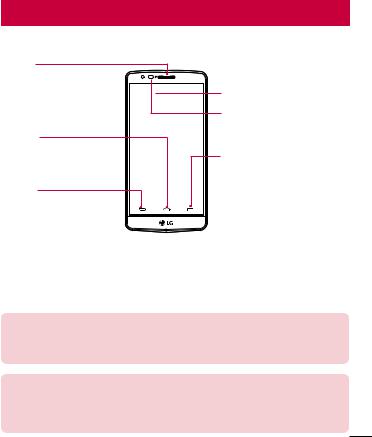
Getting to know your phone
Phone overview
Earpiece
Front-Facing Camera lens 


Home Key
Return to the Home screen from any screen. If you touch and hold this key, it opens Google Now.
Back Key
• Return to the previous screen.
• Exit an app after using it.
Notification LED
Proximity Sensor
Recent Key
Display recently used applications.
If you touch and hold this key, it opens available options menu.
NOTE: Proximity sensor
When receiving and making calls, the proximity sensor automatically turns the backlight off and locks the touch screen by sensing when the phone is near your ear. This extends battery life and prevents you from unintentionally activating the touch screen during calls.
 WARNING
WARNING
Placing a heavy object on the phone or sitting on it can damage the LCD and touch screen functions. Do not cover the LCD proximity sensor with protective film. This could cause the sensor to malfunction.
17
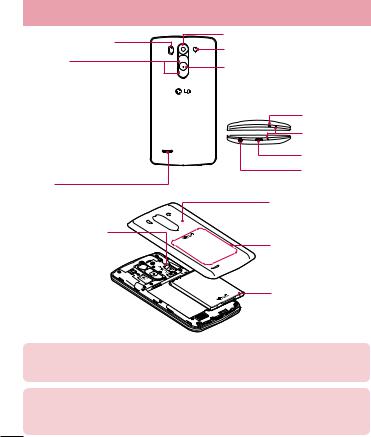
Getting to know your phone
Laser Detection AutoFocus |
Camera lens |
|||
Flash |
||||
|
|
|||
Volume keys |
Power/Lock Key |
|||
• |
In the Home screen: Control ringer volume. |
|||
• |
Switch your phone on/ off by pressing and |
|||
• |
During a call: Control your earpiece |
|||
|
holding this key. |
|||
|
volume. |
|
||
|
• |
Quick press to turn the screen off/on. |
||
• |
When playing a song: Control volume |
|||
|
IR LED |
|||
|
continuously. |
|
||
|
|
|
||
• |
Whilst screen is switched off: |
|
Microphone |
|
|
- Touch and hold Up to launch QuickMemo |
|
Charger/USB Port |
|
|
- Touch and hold Down to launch Camera |
|
||
|
|
|
||
|
|
|
Earphone Jack |
|
Speaker |
|
|
||
|
|
|
Battery cover |
|
SIM/micro SD card slots |
|
|
||
(Upper slot for micro SD and Lower |
|
NFC touch point |
||
slot for SIM) |
|
|
||
|
|
|
Battery |
|
LDAF Sensor (Laser Detection AutoFocus Sensor) : By detecting the distance with laser, when you recording with the rear camera lens, LDAF Sensor enables you to focus the long or close range more fast and accurately.
 WARNING
WARNING
Be careful not to damage the NFC touch point on the phone, which is part of the NFC antenna.
18

Installing the SIM card and battery
Before you can start exploring your new phone, you'll need to set it up. To insert the SIM card and battery.
1To remove the battery cover, hold the phone firmly in one hand. With your other hand, lift off the battery cover with your thumbnail as shown in figure.
19
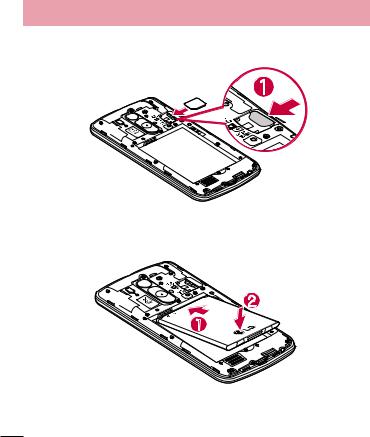
Getting to know your phone
2Slide the SIM card into its slot as shown in the fi gure. Make sure the gold contact area on the card is facing downwards.
3Insert the battery into place by aligning the gold contacts on the phone and the battery (1) and pressing it down until it clicks into place (2).
20
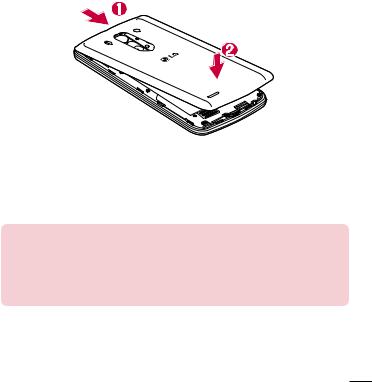
4 Align the battery cover over the battery compartment (1) and press it down until it clicks into place (2).
Charging your phone
Charge the battery before using it for the first time. Use the charger to charge the battery. A computer can be also used to charge the device by connecting them via a USB cable.
 WARNING
WARNING
Use Only LG-approved chargers, batteries, and cables. Using unapproved chargers or cables may cause the battery to charge slowly and unexpected popup messages on your phone. The use of unapproved chargers or cables may cause damage to your phone or may cause your battery to explode. Any damage to the phone or its battery from such cases are not covered by the warranty.
The charger connector is at the bottom of the phone. Insert a USB into the phone and connect it to the charger, then plug the charger into an electrical outlet.
21
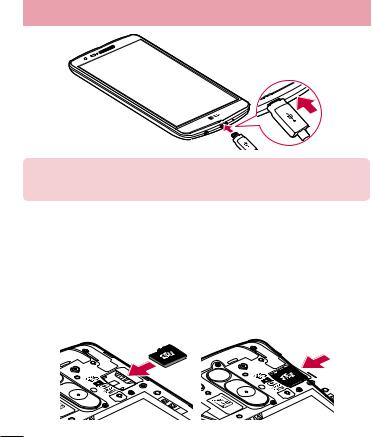
Getting to know your phone
NOTE:
•The battery must be fully charged initially to improve battery lifetime.
•Do not open the back cover while your phone is charging.
Using the memory card
Your phone supports the use of microSDTM or microSDHCTM memory cards of up to 32 GB capacity. These memory cards are specifically designed for mobile phones and other ultra-small devices, and are ideal for storing media-rich files such as music, programs, videos, and photographs for use with your phone.
To insert a memory card:
Insert the memory card into the slot. Make sure the gold contact area is facing downwards.
To safely remove the memory card:
Touch  > Apps tab > Settings > General tab > Storage > Unmount SD card.
> Apps tab > Settings > General tab > Storage > Unmount SD card.
22

NOTE:
•Use only compatible memory cards with your phone. Using incompatible memory cards may damage the card and data stored on the card, as well as the phone.
•As the device uses FAT32, the maximum size for any given file is 4 GB.
 WARNING
WARNING
Do not insert or remove the memory card when the phone is ON. Doing so may damage the memory card as well as your phone, and the data stored on the memory card may become corrupt.
To format the memory card:
Your memory card may already be formatted. If it isn't, you must format it before you can use it.
NOTE: All files on your memory card are deleted when it is formatted.
1 |
Touch |
to open the application list. |
2 |
Scroll and touch Settings > General tab > Storage. |
|
3 |
Touch Unmount SD card. |
|
4 |
Touch Erase SD card > Erase SD card > Erase everything. |
|
5 |
If you have set a pattern lock, input the pattern lock then select Erase everything. |
|
NOTE: If there is content on your memory card, the folder structure may be different after formatting, as all the files will have been deleted.
Locking and unlocking the screen
If you do not use the phone for a while, the screen will be automatically turned off and locked. This helps to prevent accidental taps and saves battery power.
When you are not using the phone, press the Power/Lock key  to lock your phone.
to lock your phone.
If there are any programs running when you lock your screen, they may be still running in Lock mode. It is recommended that you exit all programs before entering Lock mode to avoid unnecessary charges (e.g. phone calls, web access and data communications).
To wake up your phone, press the Power/Lock key  . The Lock screen will appear. Touch and slide the Lock
. The Lock screen will appear. Touch and slide the Lock
screen in any direction to unlock your Home screen. The last screen you viewed will open.
23

Your Home screen
Touch screen tips
Here are some tips on how to navigate on your phone.
Tap or touch – A single finger tap selects items, links, shortcuts and letters on the on-screen keyboard. Touch and hold – Touch and hold an item on the screen by tapping it and not lifting your finger until an action occurs. For example, to open a contact's available options, touch and hold the contact in the Contacts list until the context menu opens.
Drag – Touch and hold an item for a moment and then, without lifting your finger, move your finger on the screen until you reach the target position. You can drag items on the Home screen to reposition them.
Swipe or slide – To swipe or slide, quickly move your finger across the surface of the screen, without pausing when you first tap it (so you don’t drag an item instead). For example, you can slide the screen up or down to scroll through a list, or browse through the different Home screens by swiping from left to right (and vice versa). Double-tap – Double-tap to zoom on a webpage or a map. For example, quickly double-tap a section of a webpage to adjust that section to fit the width of the screen. You can also double-tap to zoom in and out while viewing the picture.
Pinch-to-Zoom – Use your index finger and thumb in a pinching or spreading motion to zoom in or out when using the browser or Maps, or when browsing pictures.
Rotate the screen – From many applications and menus, the orientation of the screen adjusts to the device's physical orientation.
NOTE:
•To select an item, tap the center of the icon.
•Do not press too hard; the tap screen is sensitive enough to pick up a light, yet firm tap.
•Use the tip of your finger to tap the option you want. Be careful not to tap any other keys.
Home screen
The Home screen is the starting point for many applications and functions, and it allows you to add items like application shortcuts, or Google widgets to give you instant access to information and applications. This is the default canvas and accessible from any menu by tapping 

 .
.
24

Status Bar
Shows phone's status information including the time, signal strength, battery status, and notification icons.
Widget
Widgets are self-contained applications that can be accessed through the Apps screen or on the Home screen or an extended home screen. Unlike a shortcut, the Widget appears as an on-screen application.
Application Icons
Tap an icon (application, folder, etc.) to open and use it.
Location Indicator
Indicates which Home screen canvas you are viewing.
 Quick Key Area
Quick Key Area
Provides one-touch access to the function in any home screen canvas.
Extended home screen
The operating system provides multiple Home screen canvases to provide more space for adding icons, widgets, and more.
Slide your finger left or right across the Home screen.
25

Your Home screen
Customising the Home screen
You can customise your Home screen by adding apps, widgets or changing wallpapers.
To add items on your Home screen
1 Touch and hold the empty part of the Home screen.
2In the Add Mode menu, select the item you wish to add. You will then see this added item on the Home screen.
3 Drag it to the desired location and lift your fi nger.
TIP! To add an application icon to the Home screen from the Apps menu, touch and hold the application you want to add.
To remove an item from the Home screen
Home screen > touch and hold the icon you want to remove > drag it to  .
.
To add an app as a Quick key
From the Apps menu or on the Home screen, touch and hold an application icon and drag it to the Quick key area.
To remove an app from the Quick key area
Touch and hold the desired quick key and drag it to  .
.
NOTE:  Apps key cannot be removed.
Apps key cannot be removed.
To customise apps icons on the Home screen
1Touch and hold an application icon until it is unlocked from its current position. Then drop it on the screen. The editing icon  will appear in the upper right corner of the application.
will appear in the upper right corner of the application.
2 Tap the application icon again and select the desired icon design and size. 3 Tap OK to save the change.
26

Returning to recently-used applications
1 Touch 

 . The screen displays a pop-up containing the icons of applications you used recently. 2 Tap an icon to open the application, or tap
. The screen displays a pop-up containing the icons of applications you used recently. 2 Tap an icon to open the application, or tap 

 to return to your previous screen.
to return to your previous screen.
Notifications panel
Notifications alert you to the arrival of new messages, calendar events, and alarms, as well as to ongoing events, such as when you are on a call.
When a notification arrives, its icon appears at the top of the screen. Icons for pending notifications appear on the left, and system icons such as Wi-Fi or battery strength shown on the right.
NOTE: The available options may vary depending on the region or service provider.
Pending |
Bluetooth, Wi-Fi & |
notifications |
battery status |
27
